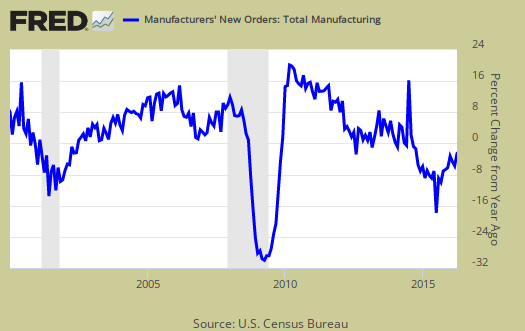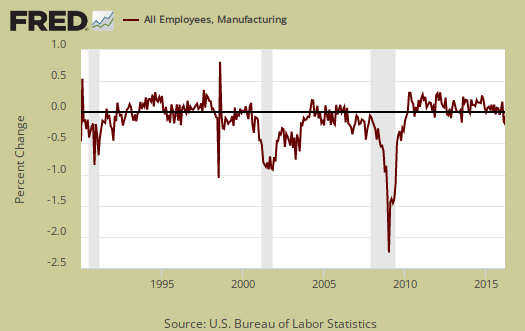The April 2016 ISM Manufacturing Survey is a ho-hum month of manufacturing molasses. While in growth, Manufacturing is barely so and inventories are in their 10th month of contraction. PMI was 50.8%, -1.0 percentage point lower than March. New orders dropped -2.5 percentage points but are still in growth. Manufacturing Employment is still contracting and has been for five months. Overall it looks like manufacturing is on the cusp with very lukewarm, treading water type of growth.

The ISM Manufacturing survey is a direct survey of manufacturers. Generally speaking, indexes above 50% indicate growth and below indicate contraction. Every month ISM publishes survey responders' comments, which are part of their survey. This month the comments were amazingly upbeat considering the actual index. Lackluster and sluggish were words used to describe business with some saying they see signs of future pick up activity.
New orders dropped -2.5 percentage points to 55.8% which is solid growth.

The Census reported March durable goods new orders increased 0.8%, where factory orders, or all of manufacturing data, will be out later this week. Note the Census one month behind the ISM survey. The ISM claims the Census and their survey are consistent with each other and they are right. Below is a graph of manufacturing new orders percent change from one year ago (blue, scale on right), against ISM's manufacturing new orders index (maroon, scale on left) to the last release data available for the Census manufacturing statistics. Here we do see a consistent pattern between the two and this is what the ISM says is the growth mark:
A New Orders Index above 52.3 percent, over time, is generally consistent with an increase in the Census Bureau's series on manufacturing orders.

Below is the ISM table data, reprinted, for a quick view.
| ISM Manufacturing April 2016 | ||||||
|---|---|---|---|---|---|---|
| Index | April 2016 | March 2016 | % Change | Direction | Rate of Change | Trend Months |
| PMI™ | 50.8 | 51.8 | -1.0 | Growing | Slower | 2 |
| New Orders | 55.8 | 58.3 | -2.5 | Growing | Slower | 4 |
| Production | 54.2 | 55.3 | -1.1 | Growing | Slower | 4 |
| Employment | 49.2 | 48.1 | +1.1 | Contracting | Slower | 5 |
| Supplier Deliveries | 49.1 | 50.2 | -1.1 | Faster | From Slower | 1 |
| Inventories | 45.5 | 47.0 | -1.5 | Contracting | Faster | 10 |
| Customers' Inventories | 46.0 | 49.0 | -3.0 | Too Low | Faster | 3 |
| Prices | 59.0 | 51.5 | +7.5 | Increasing | Faster | 2 |
| Backlog of Orders | 50.5 | 51.0 | -0.5 | Growing | Slower | 2 |
| Exports | 52.5 | 52.0 | +0.5 | Growing | Faster | 2 |
| Imports | 50.0 | 49.5 | +0.5 | Unchanged | From Contracting | 1 |
| OVERALL ECONOMY | Growing | Slower | 83 | |||
| Manufacturing Sector | Growing | Slower | 2 | |||
Production is the current, we're makin' stuff now meter declined by -1.1 percentage points from last month to 54.2%. This is still moderate growth. Production usually follows incoming orders in the next month.

ISM's manufacturing production index loosely correlates to the Federal Reserve's industrial production, but not at 50% as the inflection point, instead 51.1% to indicate growth. Below is a quarterly graph of the ISM manufacturing production index (left, maroon), centered around the inflection point, quarterly average, against the Fed's manufacturing industrial production index's quarterly change (scale right, blue). We can see there is a matching pattern to the two different reports on manufacturing production.

The manufacturing ISM employment index is in contraction although it did increase by 1.1 percentage points to 49.2%. In January 2016 the employment index was 45.9%. The neutral point for hiring vs. firing is 50.6%. Below are the BLS manufacturing non-farm payrolls (jobs) for the past decade on the left (maroon), graphed against the ISM manufacturing employment index on the right (blue). The BLS manufacturing payrolls is the monthly percentage change and the ISM manufacturing employment index is centered around it's inflection point of contraction and employment growth.

The inventories index has been contracting for the 10th month in a row, although worse, at a faster pace. Changes in inventories contributes to GDP. Inventories gives an estimate of how much raw materials manufacturers have on hand and the contraction implies manufacturers expect a slow down to continue. Quoted below is the relationship between BEA and ISM inventories, not the 50% inflection point one would assume.
An Inventories Index greater than 42.9 percent, over time, is generally consistent with expansion in the Bureau of Economic Analysis' (BEA) figures on overall manufacturing inventories in chained 2000 dollars.

Supplier deliveries are how fast manufacturers can get their supplies. A value higher than 50 indicates slower delivery times, a value below 50 means the supply chain is speeding up. The index decreased by -1.1 percentage points to 49.1% which is faster. You may wonder why slow deliveries would boost up PMI and indicate stronger growth in manufacturing. The reason is slower vendor performance means there is probably higher demand for that supply and thus indicates increasing activity.

Order backlogs declined by -0.5 percentage points to 50.5%. While this is still growth it is barely so. Less order backlogs would imply there is no need to ramp up production to catch up.

Imports increased by 0.5 percentage points to 50.0% and are now unchanged from last month's contraction. Imports are materials from other countries manufacturers use to make their products and high levels isn't too great for economies of scale in the U.S.

New orders destined for export, or for customers outside of the United States increased by +0.5 percentage points to 52.5% and thus grew faster. Manufacturing exports can imply pick up and slow down in global demand.

Prices increased 7.5 percentage points to 59.0%. Prices have increased for two months now after a long decline. The ISM gives an index correlation to BEA price increases of 52.1%.

Customer's inventories declined by -3.0 percentage points to 46.0% and are too low. Customer inventories, not to be confused with manufacturer's inventories, are how much customers have on hand, and rates the level of inventories the organization's customers have. This is not a good sign, as if customers are expecting a slow down.

Here is the ISM industrial sector ordered list of growth and contraction. Note how there are only four sectors contracting and how Petroleum is the leader.
Of the 18 manufacturing industries, 11 are reporting growth in April in the following order: Wood Products; Printing & Related Support Activities; Paper Products; Plastics & Rubber Products; Primary Metals; Fabricated Metal Products; Chemical Products; Machinery; Computer & Electronic Products; Nonmetallic Mineral Products; and Food, Beverage & Tobacco Products. The four industries reporting contraction in April are: Petroleum & Coal Products; Transportation Equipment; Miscellaneous Manufacturing; and Furniture & Related Products..
The ISM has a correlation formula to annualized real GDP. April alone gives a 2.4% annual real GDP correlation. The below graph plots real GDP, left scale, against PMI, right scale, real GDP up to Q1 2016. One needs to look at the pattern of the two lines to get anything out of this by quarters graph. If they match, GDP goes up, PMI goes up, would imply some correlation. Yet the estimate against itself is telling that a slowdown did occur at the end of the year.

The ISM manufacturing index is important due to the economic multiplier effect. This just cannot be a good thing to see the ISM manufacturing index showing contraction for so long. . U.S. manufacturing is about an eighth of the economy. Overall this month is fairly ho-hum, with the issues of concern being employment and inventory contraction. The survey isn't screaming growth or disaster yet it's not very encouraging to see yet another mixed message report.
PMI is a composite of equally weighted and seasonally adjusted New Orders, Production, Employment, Supplier Deliveries and Inventories.
The ISM neutral point is 50, generally. Above is growth, below is contraction, There is some some variance in the individual indexes and their actual inflection points as noted above. Here are past manufacturing ISM overviews, unrevised. The ISM has much more data, tables, graphs and analysis on their website. PMI™ stands for purchasing manager's index. On ISM correlations to other indexes, when in dollars they normalized to 2000 values. The above graphs do not do that, so our graphs are much more rough than what the ISM reports these indices track.
Note: The ISM is seasonally adjusting some of these indexes and not others due to the criteria for seasonal adjustment. Those indexes not seasonally adjusted are: Inventories, Customers' Inventories, Prices, Backlog of Orders, New Export Orders and Imports.

Recent comments